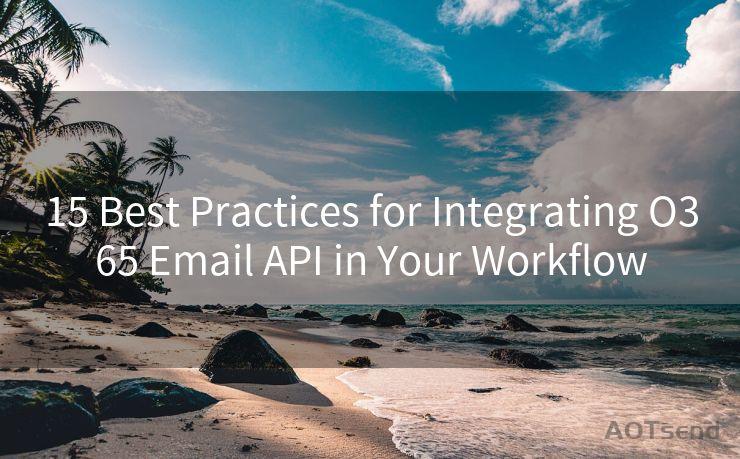15 Best Practices for Integrating O365 Email API in Your Workflow




When it comes to integrating the Office 365 Email API into your workflow, there are several best practices that can ensure a smooth and efficient integration. Following these practices will not only help you avoid common pitfalls but also maximize the effectiveness of the API in your daily operations. Here are the top 15 best practices to keep in mind:
1. Understand the API Capabilities
Before integrating the O365 Email API, it's crucial to have a thorough understanding of its capabilities. Explore the documentation, understand the endpoints, and familiarize yourself with the types of requests you can make.
2. Set Clear Goals
Define your goals and objectives for integrating the API. Whether it's for automating email tasks, fetching email data, or something else, clarity on your goals will help you focus your integration efforts.
3. Manage Permissions and Authentication
Ensure you have the necessary permissions set up correctly. Implement OAuth 2.0 authentication to securely access the API and handle user consent.
4. Handle Rate Limits and Throttling
Be aware of the rate limits and throttling policies of the O365 Email API. Design your application to handle these limitations gracefully, avoiding excessive requests that may result in your application being blocked.
5. Optimize Data Retrieval
When fetching email data, use efficient query parameters to minimize the amount of data retrieved. This not only speeds up the process but also reduces unnecessary network traffic.
6. Error Handling and Logging
Implement robust error handling mechanisms to catch and manage API errors effectively. Additionally, set up logging to track and monitor API requests and responses for troubleshooting purposes.
7. Utilize Pagination
When dealing with large datasets, utilize pagination to retrieve data in smaller chunks. This prevents memory overloads and ensures a smoother data retrieval process.
8. Secure Data Transmission
Ensure that all data transmitted between your application and the O365 Email API is securely encrypted. Use HTTPS for all API requests to maintain data integrity and confidentiality.
9. Test in a Sandbox Environment
Before deploying your integration to production, test it in a safe, sandboxed environment. This allows you to identify and resolve any issues without disrupting live services.
10. Monitor and Optimize Performance
🔔🔔🔔
【AOTsend Email API】:AOTsend is a Managed Email Service for sending transactional emails. Support Email Types: reminders, authentication, confirmations, notifications, verification codes, invoices, password resets, account activations, billing statements, two-factor authentication (2FA), and one-time passwords (OTP) emails, etc. $0.28 per 1000 Emails. 99% Delivery, 98% Inbox Rate.
You might be interested in:
Why did we start the AOTsend project, Brand Story?
What is a Managed Email API, How it Works?
Best 25+ Email Marketing Platforms (Authority,Keywords&Traffic Comparison)
Best 24+ Email Marketing Service (Price, Pros&Cons Comparison)
Email APIs vs SMTP: How they Works, Any Difference?
Regularly monitor the performance of your API integration. Look for bottlenecks, latency issues, or any other performance-related problems, and optimize accordingly.
11. Handle Changes in the API
Be prepared for changes in the O365 Email API. Subscribe to change notifications, read release notes, and update your integration when necessary to ensure compatibility.
12. Document Your Integration
Maintain detailed documentation of your API integration. This includes endpoints used, request/response formats, error handling procedures, and any other relevant information.

13. Leverage Libraries and SDKs
Utilize available libraries and SDKs provided by Microsoft or the community to simplify and accelerate your integration process.
14. Provide User Feedback
If your integration involves user interaction, provide clear and timely feedback on the status of API requests. This enhances the user experience and builds trust in your application.
15. Continuously Improve
Regularly review your integration and look for opportunities to improve. Stay updated with best practices, new features, and security updates related to the O365 Email API.
By following these 15 best practices, you can ensure a smooth, secure, and efficient integration of the O365 Email API into your workflow. Remember to stay vigilant and proactive in maintaining your integration as the API and your business needs evolve.




Scan the QR code to access on your mobile device.
Copyright notice: This article is published by AotSend. Reproduction requires attribution.
Article Link:https://www.mailwot.com/p2596.html



